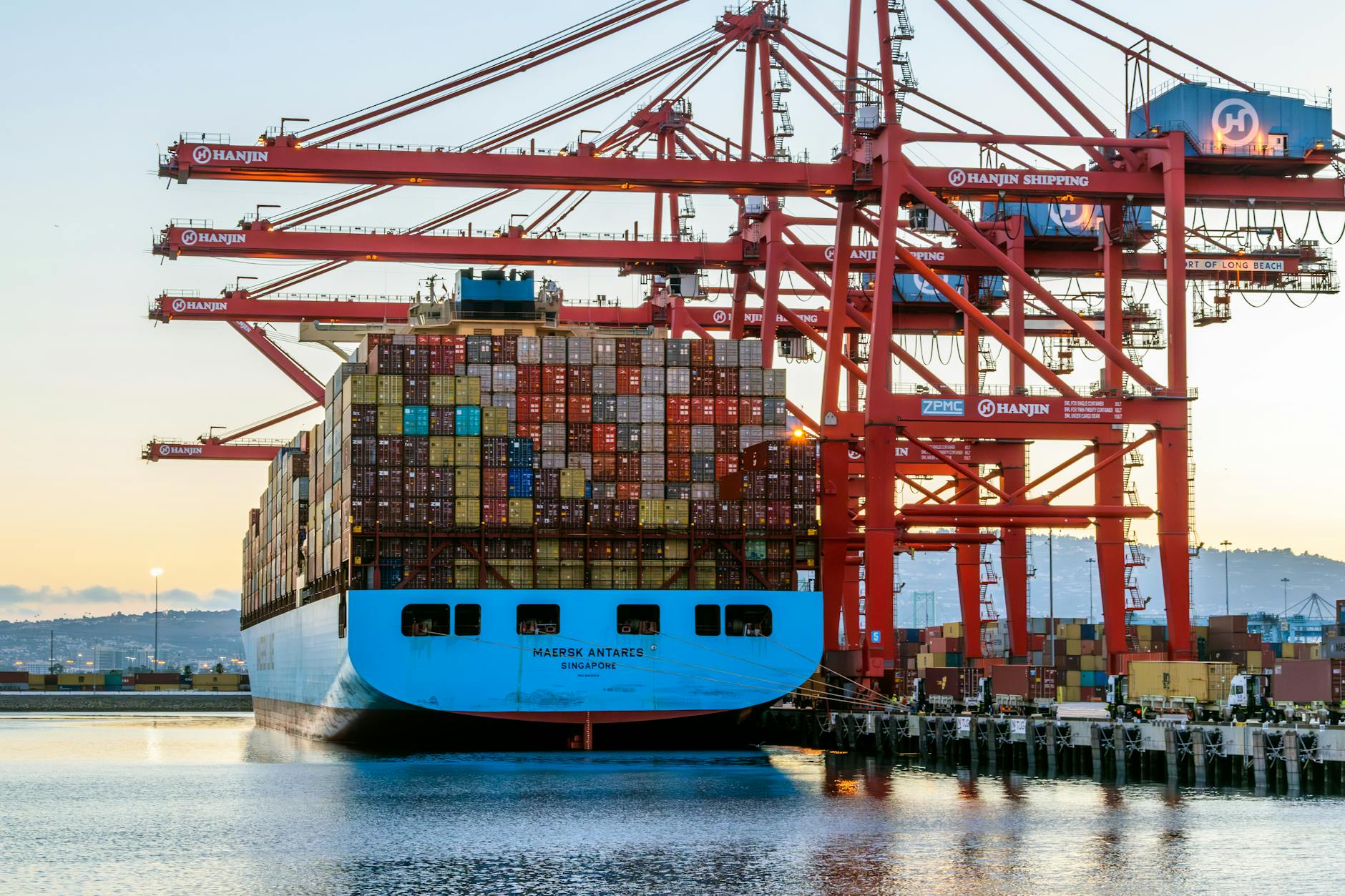The Semiconductor Tightrope: Navigating U.S. Supply, Demand, and the Specter of Tariffs
GluonTS DeepAR Modeling Reveals Complex Future for American Chip Manufacturing
The United States semiconductor industry stands at a critical juncture, facing a complex interplay of domestic supply and demand dynamics, the potential imposition of Section 232 tariffs, and the intricate global market. A recent analysis, leveraging advanced predictive modeling techniques, sheds light on the potential ramifications for key players and the broader economic landscape. This article delves into the findings, exploring the multifaceted challenges and opportunities that lie ahead for the future of semiconductors in the U.S.
Introduction
The semiconductor industry is the bedrock of modern technological advancement, powering everything from smartphones and advanced computing to critical infrastructure and national security systems. In the United States, the sector has been a subject of increasing policy focus, particularly concerning domestic manufacturing capabilities and supply chain resilience. This analysis, utilizing the sophisticated forecasting capabilities of GluonTS DeepAR, offers a data-driven perspective on the potential impacts of proposed trade policies, specifically Section 232 tariffs, on the U.S. supply and demand balance for analog and discrete semiconductors. The findings are particularly relevant for understanding the strategic positions of major industry participants such as Texas Instruments, Analog Devices, Infineon Technologies, and Renesas, shedding light on how these companies might navigate a potentially altered market.
Context & Background
The global semiconductor market is characterized by its intense competition, capital-intensive nature, and intricate, geographically dispersed supply chains. For decades, the U.S. has been a leader in semiconductor design and innovation, but a significant portion of advanced manufacturing has shifted overseas. Concerns about national security, economic competitiveness, and supply chain vulnerabilities, particularly highlighted by recent global disruptions, have spurred renewed interest in revitalizing domestic chip production.
Section 232 of the Trade Expansion Act of 1962 grants the President the authority to investigate and adjust imports that threaten national security. While historically applied to sectors like steel and aluminum, the potential application of these tariffs to semiconductors signifies a significant policy shift. The rationale behind such a move typically centers on protecting domestic industries deemed essential for national security and reducing reliance on foreign supply chains. However, the deeply integrated nature of the global semiconductor ecosystem means that protectionist measures can have far-reaching and often unintended consequences.
Analog and discrete semiconductors, while perhaps less glamorous than cutting-edge processors, are fundamental components found in a vast array of electronic devices. Analog semiconductors process real-world signals like sound and temperature, while discrete semiconductors perform basic electronic functions such as switching and amplification. Their widespread use across automotive, industrial, aerospace, and consumer electronics sectors makes their supply and demand dynamics particularly critical for the overall health of the U.S. economy.
The firms mentioned – Texas Instruments, Analog Devices, Infineon Technologies, and Renesas – represent significant players in this space. Texas Instruments and Analog Devices are U.S.-based companies with substantial design and manufacturing operations. Infineon Technologies, a German company, and Renesas Electronics, a Japanese company, are major global players with significant market share and also have a presence in the U.S. market, including design centers and, in some cases, manufacturing or assembly facilities. Understanding how a potential tariff regime would affect their operations and the broader market requires a granular analysis of their respective market positions, supply chain structures, and customer bases.
In-Depth Analysis
The analysis, conducted by Bernstein, utilized GluonTS DeepAR, a powerful open-source library for probabilistic time series forecasting developed by Amazon. DeepAR is a deep learning model that excels at capturing complex patterns and dependencies in sequential data, making it well-suited for forecasting economic variables like supply and demand. By training the model on historical data related to U.S. semiconductor production, consumption, imports, and exports, as well as economic indicators, Bernstein’s analysts aimed to project future trends under various scenarios, including the potential imposition of Section 232 tariffs.
The core of the analysis likely focused on modeling the U.S. supply and demand balance. This involves forecasting future demand for analog and discrete semiconductors, driven by factors such as economic growth, technological adoption rates (e.g., in electric vehicles, 5G infrastructure, Internet of Things devices), and defense spending. Simultaneously, the model would have projected domestic supply, considering factors like existing manufacturing capacity, planned expansions, and import levels. The introduction of tariffs would then be modeled as a shock to the system, affecting the cost of imported semiconductors, potentially leading to shifts in sourcing strategies, and impacting overall market prices and volumes.
According to the summary, the analysis points to significant implications for major companies. For U.S.-based firms like Texas Instruments and Analog Devices, the impact could be dual-edged. On one hand, tariffs on imported semiconductors could potentially benefit them by making domestically produced alternatives more competitive. However, these companies also rely on global supply chains for certain raw materials, components, or specialized manufacturing processes. Tariffs could increase their input costs or disrupt their existing supply networks. Furthermore, if tariffs lead to retaliatory measures from other countries, their ability to export products could be hampered.
For international players like Infineon Technologies and Renesas, the direct impact of tariffs would be on the cost of their semiconductors sold into the U.S. market. If tariffs significantly increase the price of their products, they might lose market share to domestic competitors or be forced to absorb some of the cost increase, thereby reducing their profit margins. Alternatively, they might seek to increase their local manufacturing or assembly presence in the U.S. to circumvent tariffs, a strategy that is often complex and capital-intensive.
The analytical findings, as suggested by “analysts led…”, likely delved into quantitative projections of these impacts. This could include estimates of price elasticity, shifts in market share, and potential impacts on gross domestic product or employment within the semiconductor sector and its downstream industries. The use of a deep learning model like DeepAR allows for the capturing of non-linear relationships and dynamic interactions between variables that traditional econometric models might miss, potentially offering a more nuanced and accurate forecast in a rapidly evolving market.
The “future of semiconductors in the U.S.” as projected by this modeling would hinge on the interplay between these economic forces and policy decisions. A scenario where tariffs successfully incentivize domestic production without severely damaging demand or increasing costs for end-users would be ideal but challenging to achieve. Conversely, a scenario where tariffs lead to significant price hikes, reduced availability, and retaliatory trade actions could have detrimental effects on the U.S. economy and its technological competitiveness.
Pros and Cons
The potential imposition of Section 232 tariffs on semiconductors presents a complex scenario with both anticipated benefits and significant drawbacks.
Potential Pros:
- Stimulation of Domestic Manufacturing: Tariffs could make imported semiconductors more expensive, thereby increasing the competitiveness of U.S.-based semiconductor manufacturing facilities. This could encourage greater investment in domestic production capacity, aligning with national security objectives of reducing reliance on foreign supply chains.
- Enhanced Supply Chain Resilience: By fostering a stronger domestic manufacturing base, the U.S. could potentially reduce its vulnerability to global supply chain disruptions, geopolitical events, or trade disputes that might impact the availability of critical chip components.
- Job Creation: Increased domestic manufacturing and related activities could lead to job creation in the U.S., spanning roles in production, engineering, research and development, and logistics.
- Intellectual Property Protection: A stronger domestic ecosystem might also offer better protection for U.S. intellectual property in semiconductor design and manufacturing processes.
Potential Cons:
- Increased Costs for Consumers and Businesses: Tariffs are essentially taxes on imports. These costs are often passed on to consumers and businesses in the form of higher prices for electronic goods and services, potentially dampening demand and economic activity.
- Reduced Competitiveness: Higher input costs for U.S. companies that rely on imported semiconductors could make their end products less competitive in the global market.
- Retaliatory Trade Measures: The imposition of tariffs by the U.S. could trigger retaliatory tariffs from other countries on U.S. exports, negatively impacting American industries.
- Disruption of Global Supply Chains: The semiconductor industry is highly globalized. Tariffs could disrupt established and efficient supply chains, forcing companies to reconfigure operations at significant cost and potential loss of efficiency.
- Limited Impact on Advanced Manufacturing: For the most advanced nodes of semiconductor manufacturing, which are highly concentrated in specific regions (e.g., Taiwan), tariffs alone might not be sufficient to incentivize the massive investment required for domestic establishment, especially without complementary industrial policies.
- Technological Disadvantage: If tariffs lead to less access to specialized foreign components or hinder collaboration, it could slow down technological progress and innovation within the U.S.
Key Takeaways
- Sophisticated Modeling Underpins Forecasts: The analysis employs GluonTS DeepAR, a deep learning method for probabilistic time series forecasting, indicating a data-driven approach to understanding future semiconductor market dynamics. This method is capable of capturing complex patterns in supply and demand.
- Section 232 Tariffs Pose Significant Uncertainty: The potential introduction of Section 232 tariffs on analog and discrete semiconductors is a key variable influencing the U.S. supply and demand balance, with profound implications for the industry.
- Impacts on Major Players Vary: U.S. firms like Texas Instruments and Analog Devices, as well as international competitors such as Infineon Technologies and Renesas, face a complex set of potential outcomes, including altered market competitiveness, cost structures, and supply chain configurations.
- Domestic Manufacturing Incentive vs. Cost Burden: Tariffs could incentivize U.S. domestic production, potentially enhancing supply chain resilience. However, they also risk increasing costs for businesses and consumers, and could lead to retaliatory trade actions.
- Analog and Discrete Semiconductors are Foundational: These categories of semiconductors are critical across numerous sectors, meaning any policy impacting their availability or cost has broad economic repercussions.
- Global Interconnectedness is Paramount: The analysis implicitly highlights the deeply interconnected nature of the global semiconductor supply chain, suggesting that unilateral trade actions can have cascading effects worldwide.
Future Outlook
The future of semiconductors in the U.S. is intricately linked to policy decisions, technological innovation, and global economic trends. The analysis suggests that a protective tariff regime, while potentially bolstering domestic manufacturing in the long term, carries significant short-to-medium term risks. These risks include increased operational costs for businesses, potential inflation for consumers, and the possibility of international trade disputes that could harm U.S. export markets.
For companies like Texas Instruments and Analog Devices, the outlook may depend on their ability to leverage existing U.S. manufacturing strengths while navigating any increased costs associated with imported inputs. Their investments in advanced packaging and specialized analog technologies could provide a competitive edge. Infineon Technologies and Renesas will likely need to closely monitor U.S. trade policy and potentially adjust their investment strategies in the U.S., perhaps by expanding local R&D or manufacturing capabilities to mitigate tariff impacts and maintain market access.
Beyond tariffs, the U.S. is also actively pursuing other avenues to strengthen its semiconductor ecosystem. Initiatives like the CHIPS and Science Act [Link to CHIPS Act legislation] aim to provide significant incentives for domestic manufacturing, research, and development. The success of these broader policy efforts, coupled with the ongoing advancements in semiconductor technology and the strategic decisions of industry leaders, will collectively shape the trajectory of the U.S. semiconductor sector.
The insights gleaned from the GluonTS DeepAR modeling provide a valuable, albeit potentially stark, view of the economic forces at play. They underscore the delicate balance the U.S. must strike between national security objectives, economic competitiveness, and the realities of a globally integrated industry. The industry’s future will likely be defined by its ability to adapt to these evolving market conditions and policy landscapes, fostering innovation while ensuring a stable and resilient supply of critical components.
Call to Action
The semiconductor industry, and by extension, the broader technological landscape, is at a pivotal moment. The insights from this advanced modeling analysis serve as a critical signal for policymakers, industry leaders, and stakeholders. Informed decision-making requires a comprehensive understanding of the potential economic ramifications of proposed policies, such as Section 232 tariffs.
For Policymakers: It is crucial to engage in thorough, data-driven impact assessments before implementing protectionist measures that could disrupt established supply chains and economic activity. A balanced approach that combines targeted incentives for domestic production, investment in research and development, workforce training, and strategic international collaborations may yield more sustainable and beneficial outcomes for the U.S. semiconductor industry and the economy at large. Continuous monitoring of global market trends and potential retaliatory measures is also essential. The U.S. Department of Commerce, International Trade Administration, provides resources and analysis on trade policy. Understanding their reports on semiconductor supply chains is vital.
For Industry Leaders: Companies like Texas Instruments, Analog Devices, Infineon Technologies, and Renesas, along with other stakeholders, should proactively analyze their own supply chain vulnerabilities and market exposures. Diversifying sourcing, exploring strategic partnerships, and investing in advanced manufacturing capabilities – both domestically and internationally, where strategic – will be key to navigating potential trade barriers and market shifts. Staying abreast of legislative actions, such as those championed by the Semiconductor Industry Association (SIA), is also paramount.
For the Public and Businesses: Awareness of the critical role semiconductors play in everyday life and the economy is important. Understanding how trade policies can influence the cost and availability of electronic goods is essential. Supporting policies that foster innovation and robust supply chains, while also ensuring affordability and market access, will contribute to a stronger and more resilient technological future.
Ultimately, the path forward for U.S. semiconductors necessitates a collaborative effort to foster innovation, enhance manufacturing capabilities, and ensure global competitiveness, all while navigating the complexities of international trade. The data provided by advanced modeling tools like GluonTS DeepAR offers a critical lens through which to view these challenges and opportunities, guiding strategic decisions towards a more robust and secure technological future.









